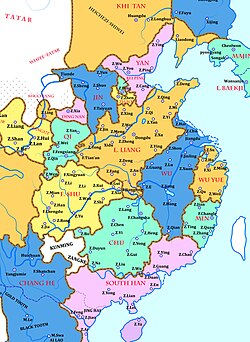Wuyue Kingdom
| Wuyue | ||||||||||
| 吳越 | ||||||||||
| Tributary state of Later Liang, Later Tang, Later Jin, Liao, Later Han, Later Zhou and Song | ||||||||||
|
||||||||||
|
China during the early Five Dynasties and Ten Kingdoms period. A prefix of "F." indicates a city suffixed with "-fu", a prefix of "Z." indicates a city suffixed with "-zhou".
|
||||||||||
| Capital |
Qiantang (Main court; Capital) Yuezhou (Eastern court) |
|||||||||
| Languages | Wu Chinese | |||||||||
| Government | Monarchy | |||||||||
| King | ||||||||||
| • | 907–932 | Qian Liu | ||||||||
| • | 932–941 | Qian Yuanguan | ||||||||
| • | 941–947 | Qian Hongzuo | ||||||||
| • | 947 | Qian Hongzong | ||||||||
| • | 947–978 | Qian Chu (Qian Hongchu) | ||||||||
| Historical era | Five Dynasties and Ten Kingdoms Period | |||||||||
| • | Zhenhai Military Governorate | 886 | ||||||||
| • | Fall of the Tang Dynasty | 907 | ||||||||
| • | Submitted to Song | 978 | ||||||||
| • | Extinguishment | 988 | ||||||||
| Currency | Chinese cash, Chinese coin | |||||||||
|
||||||||||
Wuyue (simplified Chinese: 吴越; traditional Chinese: 吳越; pinyin: Wúyuè; Shanghainese: [ɦuɦyɪʔ]), 907–978, was an independent coastal kingdom founded during the Five Dynasties and Ten Kingdoms (907–960) of Chinese history. It was ruled by the Qian family, which remains widespread in the kingdom's former territory.
Beginning in 887, the Qian family provided military leaders to the Tang Dynasty. Qian Liu was named Prince of Yue in 902, with the title of Prince of Wu added two years later. In 907, when the Tang Dynasty fell and was replaced in the north by the Later Liang, military leaders in the south formed their own kingdoms. Qian Liu used his position to proclaim himself the King of Wuyue. This signaled the beginning of the Five Dynasties and Ten Kingdoms period which would last until the founding of the Song Dynasty in 960.
The name Wuyue comes from the combination of Wu Kingdom and Yue Kingdom, two ancient kingdoms during the Spring and Autumn period from 770 to 476 BC.
With its capital in Hangzhou, also called "Xifu", the kingdom included present-day Zhejiang, Shanghai, along with the southern portion of Jiangsu Province. It also later absorbed some of the northern part of Fujian when the Min Kingdom fell in 945. The territorial extent of Wuyue roughly corresponded to the territories of the ancient Yue, but not the ancient Wu—which led to charges by the neighboring Wu (also known as Southern Wu) that Wuyue had designs on its territory, and the name was a source of tension for years between the two states.
...
Wikipedia

